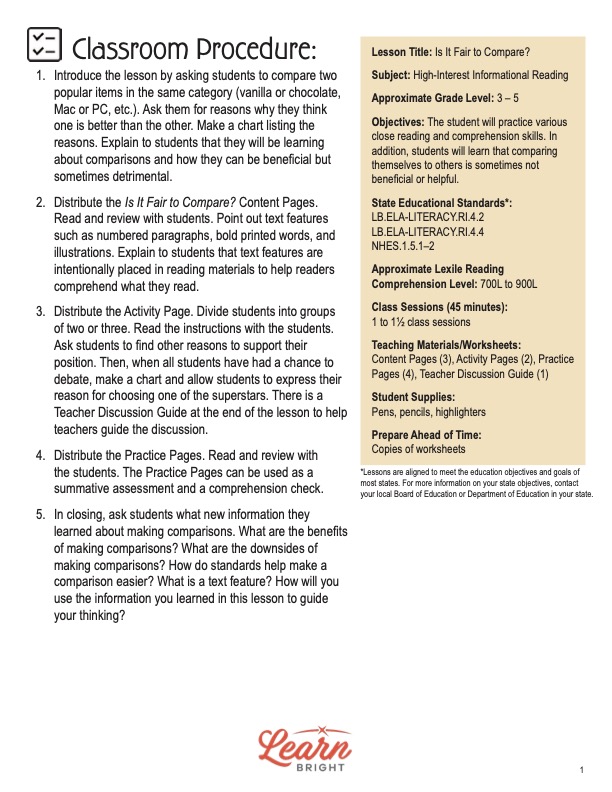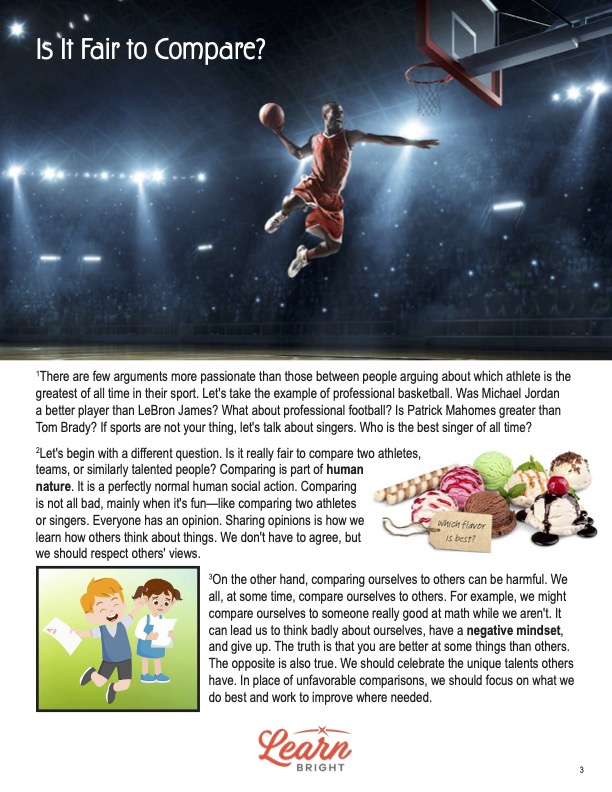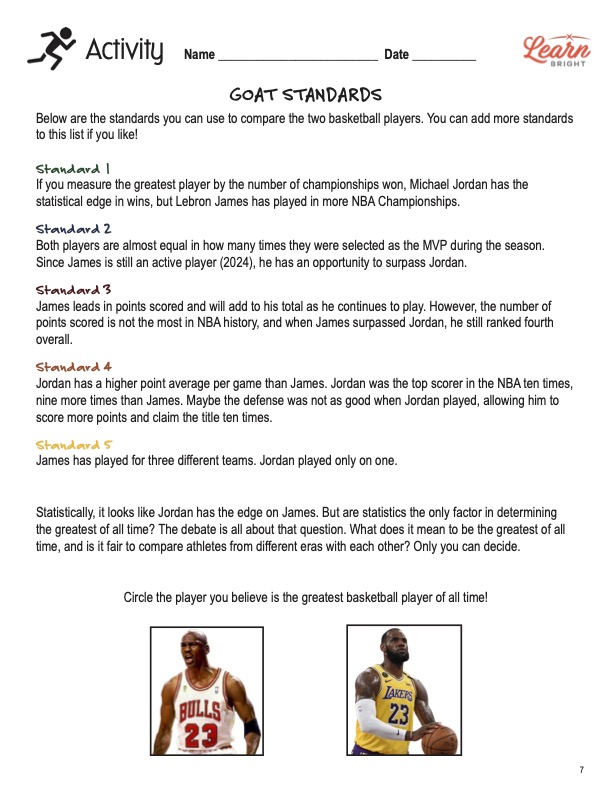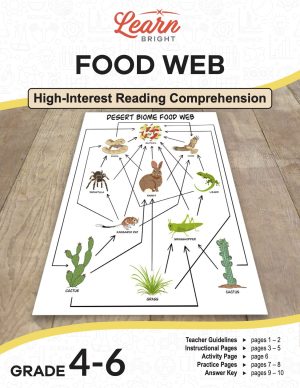Description
What our Is It Fair to Compare? lesson plan includes
Lesson Objectives and Overview: Is It Fair to Compare? is a high-interest reading comprehension lesson plan. As such, students will practice various close reading and comprehension skills. In addition, they will learn that comparing themselves to others is sometimes not beneficial or helpful. This lesson is for students in 3rd grade, 4th grade, and 5th grade.
Classroom Procedure
Every lesson plan provides you with a classroom procedure page that outlines a step-by-step guide to follow. You do not have to follow the guide exactly. The guide helps you organize the lesson and details when to hand out worksheets. It also lists information in the yellow box that you might find useful. You will find the lesson objectives, state standards, and number of class sessions the lesson should take to complete in this area. In addition, it describes the supplies you will need as well as what and how you need to prepare beforehand.
Teacher Notes
The paragraph on this page gives you a little more information on the lesson overall and describes what you may want to focus your teaching on. It explains that you can teach this lesson in a whole-class setting or as an independent, small-group activity. The blank lines are available for you to write out any thoughts or ideas you have as you prepare.
IS IT FAIR TO COMPARE? LESSON PLAN CONTENT PAGES
Pros and Cons of Comparisons
The Is It Fair to Compare? lesson plan contains three content pages. There are few arguments more passionate than those between people arguing about which athlete is the greatest of all time in their sport. Let’s take the example of professional basketball. Was Michael Jordan a better player than LeBron James? What about professional football? Is Patrick Mahomes greater than Tom Brady? If sports are not your thing, let’s talk about singers. Who is the best singer of all time?
Let’s begin with a different question. Is it really fair to compare two athletes, teams, or similarly talented people? Comparing is part of human nature. It is a perfectly normal human social action. Comparing is not all bad, mainly when it’s fun—like comparing two athletes or singers. Everyone has an opinion. Sharing opinions is how we learn how others think about things. We don’t have to agree, but we should respect others’ views.
On the other hand, comparing ourselves to others can be harmful. We all, at some time, compare ourselves to others. For example, we might compare ourselves to someone really good at math while we aren’t. It can lead us to think badly about ourselves, have a negative mindset, and give up. The truth is that you are better at some things than others. The opposite is also true. We should celebrate the unique talents others have. In place of unfavorable comparisons, we should focus on what we do best and work to improve where needed.
Are there positive benefits to comparing ourselves to others? Suppose you are trying to improve something. You can compare yourself to someone very accomplished in the activity you want to get better in. You can learn what makes that person successful. Then, you can use what you learn to set incremental goals. These are small steps you can take to get better at something. You may not ever be as good as the person you want to emulate. However, you will be motivated, improve, and move closer to your goal!
Take It Step by Step
So, where do you begin? First, you need to create a standard you use to compare. A standard is something to help you measure your progress. For example, let’s say your goal is to complete 25 push-ups in one minute. You set a timer for one minute and start doing push-ups. When the timer dings, you have completed 12 push-ups, which is the standard. That also means 12 is your starting benchmark. Your standard is the number of push-ups you can do in a minute. Right now, your benchmark matches your standard.
Your next step is to talk with a push-up expert. Someone who can easily do 25 or more push-ups in a minute. You can learn from them what they did to become good at doing push-ups. You are not going to compare the number of push-ups you can do to theirs. Instead, you will compare your methods of training.
From the expert, you learn that they would try to do one extra push-up in a minute every day. Sometimes, they made their goal. Other times, they didn’t. Over time, with practice, they began to inch upward in the number of push-ups they could do per minute. You think, That sounds like a good plan to follow. You are now ready to set your incremental goals.
Set your first incremental goal to 13 push-ups in a minute. You already know you can do 12, so add one more. Once you can do 13, you reset the goal to 14, and so on until you can finally do 25 push-ups in a minute. Your benchmark changes every time you increase the number of push-ups. Your standard of the number of push-ups completed in a minute doesn’t change. You are comparing your progress to your standard, not to what someone else can do! Do you see the difference?
Tips for Comparing Positively
With that in mind, here are some things you can do to use comparing as a positive action, not a negative one. By taking these steps, you can achieve nearly anything you want. Remember, comparisons are neither good nor bad. What you do with them and how you use them makes them positive or negative!
- Be grateful for what you have. In life you will learn there will always be someone taller, faster,
smarter, and wealthier than you. There are just as many people who have less than you. Be grateful
for what you have and where you’re at. - Remember that comparing yourself to others can be harmful. You are unique with unique
abilities. Comparing can lead to low self-esteem and negative thinking. It can keep you from trying
new things or, worse, from pursuing things you love. - Focus on a standard, not a person. Standards are a way of measuring things. They are not
personal. They measure how far you have come from where you started. If you make an 80 on your
math test and your best friend a 95, it doesn’t mean you are not as “math smart” as your friend.
The next time you take a math test, make an 82, then 85, and so on. Your personal improvement
represents you, not your friend’s math score. - Nobody is perfect. Here’s a thought: Someone is probably looking at you and thinking, If only I
could be as good as they are. All of us struggle with negatively comparing ourselves with others.
So, be kind and not judgmental. Don’t waste energy on what someone else is doing. Focus on self-
improvement.
IS IT FAIR TO COMPARE? LESSON PLAN WORKSHEETS
The Is It Fair to Compare? lesson plan includes two worksheets: an activity worksheet and a practice worksheet. Each one will help students solidify their grasp of the material they learned throughout the lesson. You can refer to the classroom procedure guidelines to know when to hand out each worksheet.
JORDAN VS JAMES ACTIVITY WORKSHEET
For this activity, students will have to decide whether Michael Jordan or LeBron James is the GOAT (greatest of all time) of basketball. They will first read the short paragraph at the top of the page and review some stats in the chart. Then, they will choose a standard to base their judgment against as they decide who the GOAT is between Jordan and James.
IS IT FAIR TO COMPARE? PRACTICE WORKSHEET
The practice worksheet requires students to answer a series of 10 questions. These questions all relate to the content pages, so students will need to refer to them often for the answers. In addition, each question provides which reading tool the question corresponds to, such as text feature, vocabulary, or comprehension.
Worksheet Answer Keys
At the end of the lesson plan document is an answer key for the practice worksheet. The correct answers are all in red to make it easier for you to compare them with students’ responses. If you choose to administer the lesson pages to your students via PDF, you will need to save a new file that omits these pages. Otherwise, you can simply print out the applicable pages and keep these as reference for yourself when grading assignments.









